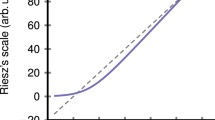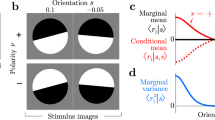Abstract
We create a framework based on Fisher information for determining the most effective population coding scheme for representing a continuous-valued stimulus attribute over its entire range. Using this scheme, we derive optimal single- and multi-neuron rate codes for homogeneous populations using several statistical models frequently used to describe neural data. We show that each neuron's discharge rate should increase quadratically with the stimulus and that statistically independent neural outputs provides optimal coding. Only cooperative populations can achieve this condition in an informationally effective way.
Similar content being viewed by others
References
Abbott L, Dayan P (1999) The effect of correlated variability on the accuracy of a population code. Neural Comput. 11: 91-101.
Bethge M, Rotermund D, Pawelzik K (2002) Optimal short-term population coding: When Fisher information fails. Neural Comput. 14: 2317-2351.
Cramér H (1946) Mathematical Methods of Statistics. Princeton University Press.
Dan Y, Alonso J-M, Usrey W, Reid R (1998) Coding of visual information by the precisely correlated spikes in the lateral geniculate nucleus. Nature Neurosci. 1: 501-507.
deCharms R, Merzenich M (1996) Primary cortical representation of sounds by the coordination of action-potential timing. Nature 381: 610-613.
Gawne T, Richmond B (1993) How independent are the messages carried by adjacent inferior temporal cortical neurons? Neuroscience 13: 2758-2771.
Gerstein G, Bedenbaugh P, Aertsen A (1989) Neuronal assemblies. IEEE Trans. Biomed. Engineering 36: 4-14.
Holgate P (1964) Estimation for the bivariate Poisson distribution. Biometrika 51: 241-245.
Jenison R (2000) Correlated cortical populations can enhance sound localization performance. J. Acoust. Soc. Am. 107: 414-421.
Johnson D (1996) Point process models of single-neuron discharges. J. Comp. Neuroscience 3: 275-299.
Johnson D (2004) Neural population structures and consequences for neural coding. J. Comp. Neurosci. 16: 69-80.
Johnson D, Gruner C, Baggerly K, Seshagiri C (2001) Information-theoretic analysis of neural coding. J. Comp. Neurosci. 10: 47-69.
Johnson D, Kiang N (1976) Analysis of discharges recorded simultaneously from pairs of auditory nerve fibers. Biophysical J. 16: 719-734.
Lehmann E, Casella G (1998) Theory of Point Estimation, 2nd edn. Springer-Verlag, New York.
Miller K, Troyer T (2002) Neural noise can explain expansive, power-law nonlinearities in neural response functions. J. Neurophysiol. 87: 653-659.
Nirenberg S, Carcieri S, Jacobs A, Latham P (2001) Retinal ganglion cells act largely as independent encoders. Nature 411: 698-701.
Panzeri S, Schultz S, Treves A, Rolls E (1999) Correlations and the encoding of information in the nervous system. Proc. Royal Soc. Lond. 266: 1001-1012.
Perkel D, Bullock G (1968) Neuronal coding. Neurosci. Res. Prog. Bull. 6: 221-348.
Pola G, Thiele A, Hoffmann K-P, Panzeri S (2003) An exact method to quantify the information transmitted by different mechanisms of correlational coding. Network: Computation in Neural Systems 14: 35-60.
Reich D, Mechler F, Victor J (2001) Independent and redundant information in nearby cortical neurons. Science 294: 2566-2568.
Seung H, Sompolinsky H (1993) Simple models for reading neuronal population codes. Proc. Natl. Acad. 90: 10749-10753.
Shamir M, Sompolinsky H (2001) Correlation codes in neuronal populations. In: Dietterich T, Becker S, Ghahramani Z, eds. Advances in Neural Information Processing Systems, vol. 14, MIT Press, Cambridge, MA, pp. 277-284.
Sinanovi? S, Johnson D (2003) Toward a theory of information processing. In preparation.
Sompolinksy H, Yoon H, Kang K, Shamir M (2001) Population coding in neuronal systems with correlated noise. Phys. Rev. E. 64: 051904.
Stein R (1967) The information capacity of nerve cells using a frequency code. Biophysical J. 7: 67-82.
Wilke S, Eurich C (2002) Representational accuracy of stochastic neural populations. Neural Comput. 14: 155-189.
Wu S, Amari S, Nakahara H (2002) Population coding and decoding in a neural field: A computational study. Neural Computation 14: 999-1026.
Zohary E, Shadlen M, Newsome W (1994) Correlated neuronal discharge rate and its implications for psychophysical performance. Nature 370: 140-143.
Author information
Authors and Affiliations
Rights and permissions
About this article
Cite this article
Johnson, D.H., Ray, W. Optimal Stimulus Coding by Neural Populations Using Rate Codes. J Comput Neurosci 16, 129–138 (2004). https://doi.org/10.1023/B:JCNS.0000014106.09948.83
Issue Date:
DOI: https://doi.org/10.1023/B:JCNS.0000014106.09948.83




